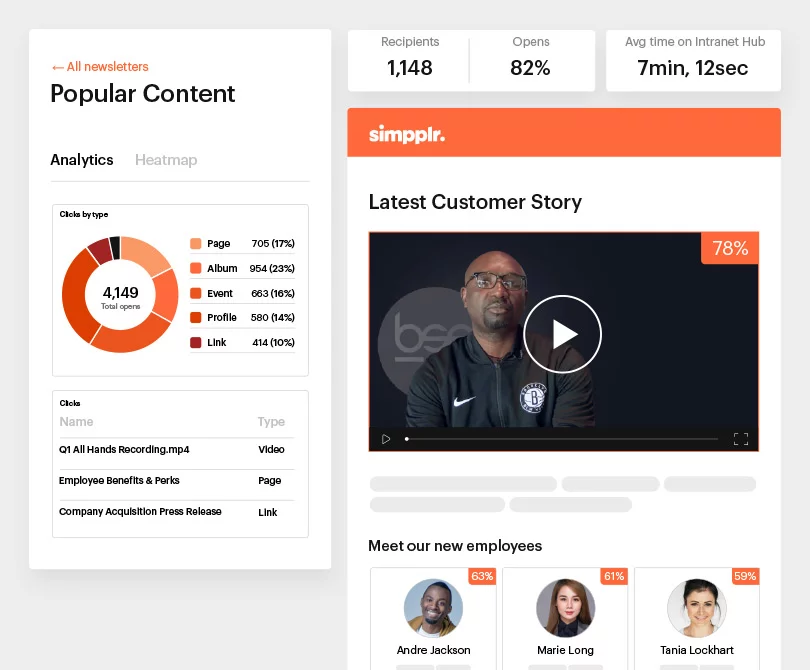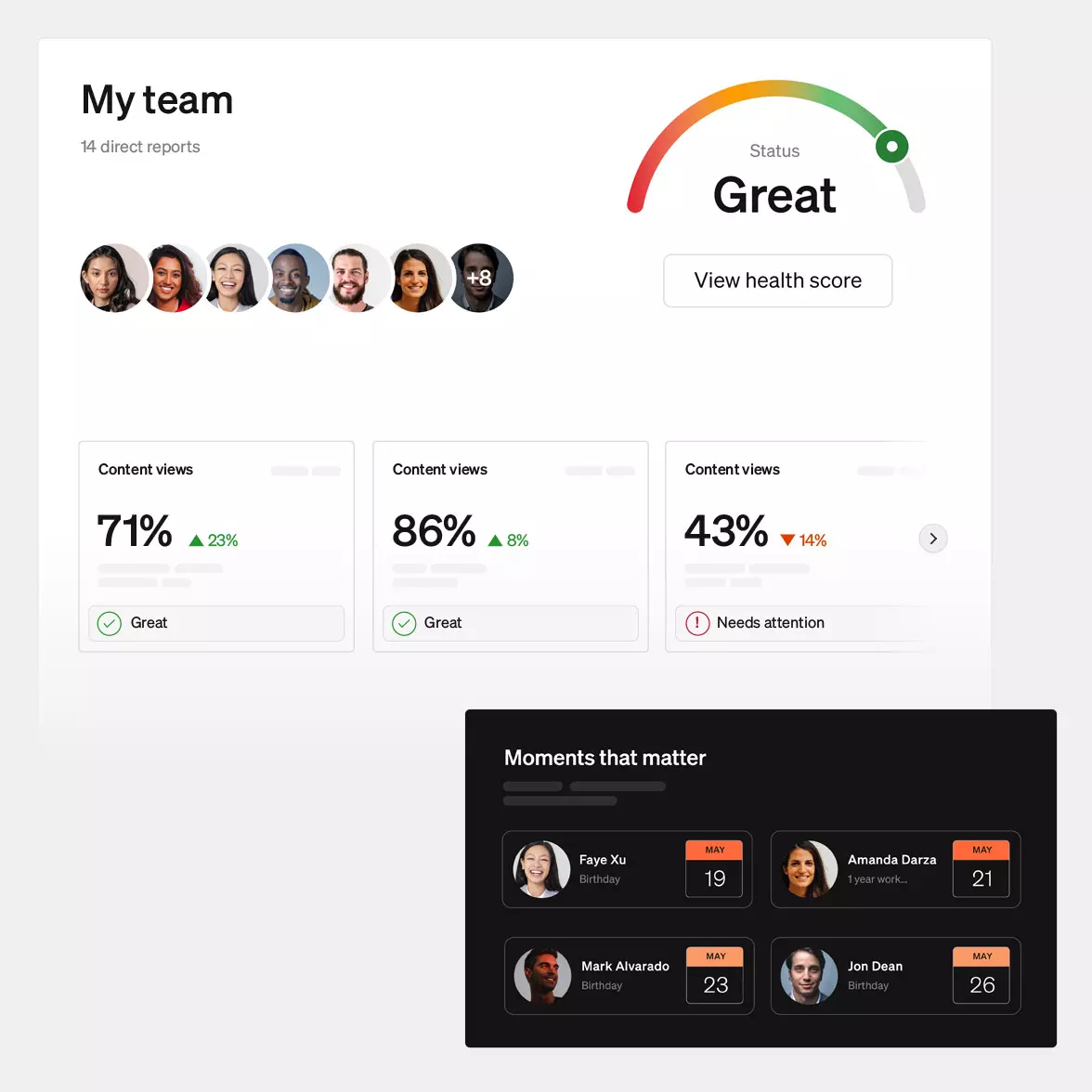- 1 Employee communication defined
- 2 Employee communication benefits
- 3 How to implement an employee communication strategy
- 4 How to implement an employee communication strategy
- 5 How technology can improve employee communication
- 6 Employee communication tools
- 7 Employee communication metrics and KPIs to measure effectiveness
Employee communication defined
Simply put, employee communication is the sharing of information, ideas and feelings between employees and the managers of an organization. Employee communication can be verbal, over email, through mobile applications, within intranets, or various other collaboration tools.
Employee communication is crucial for the strength and well-being of an organization. It is a vital element in leading and inspiring employees. A well-planned strategy for employee communication is the foundation of every successful organization.
Employee communication benefits
Improves employee engagement
Employee communication and employee engagement go hand in hand. We can all agree that it is crucial that employees receive the necessary information that they need to do their job effectively. But they also need to be able to offer feedback. When they feel more connected, both to the company and each other, through efficient communication, they become more productive and motivated to be more engaged in their daily responsibilities. And organizations with good employee communication have high engagement levels.
Maintains workplace flow
Communication problems can create stress and disrupt the flow of work in your organization. Clear and transparent employee communication helps prevent issues and resolve those that occur quickly.
Having open communication between managers and employees helps preserve a harmonious workplace collaboration.
Cultivates an inclusive workplace
Everyone wants to feel a part of the team at work. Having a solid employee communication strategy assures that no one is left out despite having different ideologies, backgrounds, or perspectives. Success happens when everyone feels like they are heard and their opinions are valued. This is key to cultivating a cohesive workplace.
Improves the employee experience
Employee communication should go beyond being the way your organization relays information to your team. It should enhance the employee experience giving purpose and meaning to their daily tasks. It should arm your employees with the right resources, tools, and information to make their job easier.
High-level employee communication will support your team to thrive both in and out of the workplace, helping them feel connected, included, and empowered to excel.
Encourages innovation
We know that stellar employee communication encourages collaboration, and from that collaboration, innovation is inevitable. When your organization arms its team with the tools to effectively share information and ideas, they get to see everyone’s perspectives and genuinely become a cohesive team. Innovative ideas naturally begin to flow with ease.
Increases inter-departmental cooperation
Each part of your organization has a purpose. They are all vital parts of the body that depend on each other to operate individually and collectively. As we discussed above, with innovation, it’s paramount that departments can communicate with one another for continuous collaboration and support. If you want to reach goals and achieve success, everyone must understand where you’re going.
Improves employee production
Employee communication helps improves employee production. This benefit should be a given as it’s a direct result of every factor listed above, and it is an important benefit to detail. One of the major objections that organizations have to remote and hybrid work is low production rates. But, in fact, McKinsey found that connected employees in either remove or hybrid work environments improve their production by 20-25%.
And this struggle can be addressed and resolved by investing in an effective employee communication strategy.
How to implement an employee communication strategy
Identify goals
Establishing well-defined objectives is fundamental to any successful employee communication plan. Without specifying your targets, your strategy may lack focus, leading to unnecessary expenditure of resources. Goals also foster cohesion among your team members by ensuring they are all working towards the same endpoint. Properly disseminating these objectives can motivate your employees, providing them with a clear understanding of their role and contribution.
What problems are you trying to solve? How will this strategy help to overcome them? Take the answers to these questions and then align your employee communications strategy to answer them.
Focus on what you want to achieve with your internal communication strategy and how these objectives tie to your broader goals as an organization.
Determine your organization’s audience
Everyone is different when it comes to styles and preferences of communication. There is no one size fits all solution to employee communication. Knowing the capabilities of your team is the best way to approach your strategy.
It should be flexible enough to accommodate their capabilities and daily tasks. And accomplish this goal without being spread thinly across different platforms. An easy solution is launching an intranet platform that facilitates personalized communication styles under the same umbrella.
Choose communication channels
You most likely have an abundance of tools, such as emails, intranets, and various apps, to support your employee communications. It’s necessary to learn how each outlet can support your goals and incorporate them into a unified platform.
A unified platform, like an intranet, will ensure that internal communication channels are cohesive. The rule of seven is that most folks need to hear and read a message seven times before it sinks in. It’s important to spread your message across various channels if you expect to be heard.
Create a schedule
Timeframes are a great way to foster a cohesive work environment where everyone is aligned with your plans. This approach can significantly progress towards your objectives while demonstrating the power of effective employee communication.
Involve employees
From the earliest planning stages all the way through implementation, you must involve employees in your communication strategy. There are various different people fulfilling distinct and vital roles within any organization. If you expect your communication strategy to succeed, every employee must be involved.
Gallup’s State Of The Global Workplace report discovered that “85% of employees are not actively engaged or (are) actively disengaged at work.” It is essential for organizations to prioritize a robust employee communication strategy that encourages participation and engagement from all staff members. Improving employee communication will not only boost engagement but also enhance productivity and morale within the workplace.
Monitor and adjust
Employee communication is more than just a one-and-done task. It must be constantly monitored and adjusted as your team changes and grows. Consistently gathering and measuring employee feedback will allow you to see where your communication is failing.

A way to enhance your practices is to deploy an intranet platform embedded with real-time prescriptive analytics functionality. This is especially critical when it comes to employee communication, to identify and rectify any holes in your communication before they negatively impact your business. Employee communication is vital in ensuring smooth workflow and fostering a harmonious working environment. Therefore, paying keen attention to any gaps and mending them promptly is of utmost importance.
How to implement an employee communication strategy
Use a variety of communication channels
To ensure your message reaches everyone, no matter their communication style or location, use a variety of communication channels. Whether it’s email, your organization’s social app, or old-fashioned employee newsletters, communications should be accessible to all.

Encourage open and honest communication
The best way to encourage your employees to engage with your communications is to allow for an open door of communication where they feel safe enough to express themselves and can be honest. This helps build trust and unity amongst management and employees.
Provide feedback regularly
How you relay feedback is critical to keeping the lines of communication open between management and employees. Being aggressive or too brash when correcting a wrong in the workplace can cause employees to shut down and distrust management. Balancing candor and care will go a long way when relaying unpleasant news.
Effective employee communication often hinges on delivering feedback in an honest and considerate manner. Opt for specific references to the individual’s skills or achievements instead of generalized praise like “you did a great job”. This approach not only enhances the quality of employee communication but also assures staff that their efforts are appreciated and recognized in a meaningful way.
Foster a sense of transparency
Transparency is imperative for a successful employee communication strategy. When you communicate openly with your employees, they gain a clear picture of the mission of your organization. This, in turn, develops a consistent agenda across all departments and keeps confusion and misunderstandings at bay.
Effective employee communication allows your team to adjust quickly to changes. Clearly communicating the intentions behind the changes and how they align with the organization’s overall mission builds trust and ensures that everyone is in accord.
Gallup found in a 2021 survey that only 17% of employees strongly agree that “there is open communication throughout all levels of the organization.”
Make communication a priority
Smart leaders understand that communication is key to their organization’s success, and they make it their priority. They know that effective communication demands that employees are well-informed and the channels of communication are a two-way street allowing for feedback both to and from employees.
For more tips, check out How to improve internal communication: 9 tips.
How technology can improve employee communication
Technology improves every aspect of employee communication. From smartphones to computers, apps, and intranets, tech is the backbone of every high-level employee communication strategy.
Technology helps to facilitate real-time communication, provides a centralized platform, improves the reach and speed of communication, and enhances collaboration. Overall, technology is an invaluable tool for improving employee communication and helping organizations to stay connected and productive.
Employee communication tools
Intranet
Setting clear goals and implementing an employee communications strategy with the support of the right intranet platform to assist will have your team communicating efficiently and effectively, regardless of its size or location.
Another great benefit of a modern intranet is that it creates a single source of truth. This helps ensure clarity across different communication channels.

Leveraging employee communication effectively is pivotal for any business to thrive. Amongst the myriad of communication channels, email stands out as a highly effective one, if wielded appropriately. It offers a prompt and inclusive way for getting a message out, fostering productive and streamlined communication within the workforce.
Prioritize efficiency and relevance in your employee communication strategy. Try to keep emails concise and consider how to reduce the frequency without compromising on essential updates. When your employees perceive that each communication piece holds significance, it improves engagement and absorption of the information provided.
Mobile apps
One of the most efficient tools of communication is the smartphone. The modern employee is not always attached to a desk or computer. Smartphones allow your team the ability to stay up to speed on communications within your organization, even if they work remotely.
Mobile apps are a great way to encourage community, information sharing, and engagement. They help ensure that all employees across your organization can communicate and contribute to company discussions, no matter where they’re based. Make sure that your employee communications are geared towards mobile.
Video and podcast
If your organization isn’t utilizing videos and podcasts, you may be missing out on a highly effective and efficient form of communication. Statista found that over 82 million people listened to podcasts in 2021, and they expect that number to rise to over 100 million listeners in 2024. There are many different ways that people communicate. Video and podcasts give your organization a creative way to convey your message.
Gamification
Gamification is a great way to foster engagement and bring a fresh approach to employee communication. Incorporating quizzes and online competition helps build community and excitement within your organization.
Gamification is an excellent tool for training your team or onboarding new hires. It’s fun and encourages folks to think outside the box. This may be a new approach to employee communication, but it can yield great returns for your organization.
Employee Collaboration Tools
One of the most effective channels for employee communication is collaboration tools. Collaboration tools encourage dialogue between inter-department teams and promote communication in small groups working to achieve a common goal. The best part is that communications are all in real time.
Surveys and feedback forms
Online surveys and feedback mechanisms foster enhanced employee communication by providing insights into areas where management is excelling or needs improvement. These tools empower employees to voice their thoughts and concepts freely. When employees feel their voice is heard, it bolsters their involvement at work. Moreover, rather than traditional quarterly or yearly surveys, real-time analytics and sentiment checks that provide understanding of employee sentiments will significantly boost the effectiveness of your communications.

Employee communication metrics and KPIs to measure effectiveness
Measuring KPIs helps identify the information and type of content that employees respond to best. This allows organizations an inside view of what’s working and what’s not.
There are a number of metrics that organizations can use to measure the effectiveness of their employee communication efforts. Some examples include:
- employee engagement
- employee satisfaction
- communication channel usage
- feedback rates
- productivity
All of these metrics are an excellent way to determine if your message is getting across to your team. A good intranet platform can help you gauge the effectiveness of your communications channels by providing real-time analytics.
To learn how an intranet can help your employee communication efforts, reach out for a demo today!






